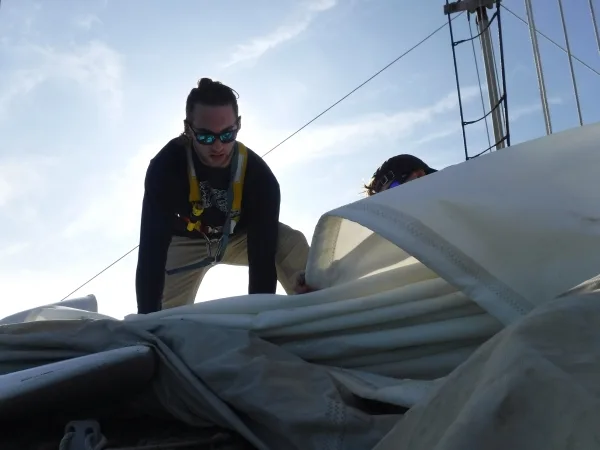Programs Blog
Finding a New Home on Bobby C.

Justin Sankey, Lawrence Universityhttps://sea.edu/wp-content/uploads/2022/08/Science_Report_small.jpg
Ship’s Log
Position
40 degrees 26.2’ S, 177 degrees 53.5’ E, southbound toward Wellington.
I’ll be the first to admit that I’ve been a little homesick lately. This being said, I have also come to think of this ship as my home, with all of its weird and wonderful quirks. I can finally find my way around the ship in the pitch black and recognize my friends/shipmates in the dark before hearing their voice. I know the schedule and how things are done without having to look at the SOP sheets anymore. There’s also the little things like learning all of the line names and no longer giving the watch officers a questioning look when they yell things out like “hands to set the mains’l” or “haul away fore stays’l halyard.” We have all come together to function as one big happy family and an effective crew. We students are even beginning to take on more responsibilities as we move into the “shadow phase” of our time on the ship. Just today, I was first shadow on morning watch and had to call the sail handling to strike the main and fore stays’ls. Grace, Ashby, and I had to furl the sails on our own for the first time. And an hour after striking all of our sails, we had to set the main stays’l again to help heave-to for science deployments.
It has definitely been a process to become accustomed to living at sea. Learning to sleep during the day while dealing with the rolling and pitching of the ship as the swell and wind push Bobby C. around has probably been one of the most difficult things to do. Despite not always getting the best sleep and being hove-to for a couple days as strong gales from the south slowly pushed us back to the north, I would say we have done a good job of keeping up moral and putting the good of the ship and crew before our own. Everyone, despite being tired, bedraggled and a little, or very seasick, has been able to stay focused and do their jobs diligently during watch and find time to work on our projects and papers outside of class while remembering to make time to have fun.
Classes and meetings have been full of interesting topics and the mates, scientists, and professors are all focused on making us understand things that are occurring around us. We have learned about the physics behind allowing our sails to move us through the water in a relatively straight line. We learned about how the gales that forced us to heave-to for several days were driven by a high pressure system that produced anti-cyclonic southerly winds. We have learned all about the mariners of old and connected their experiences with ours thanks to Maritime History and Culture. And our watch officers have even begun teaching us how to shoot stars with our sextants to determine our latitude and longitude.
One thing that I will say was hard to get used to was not seeing land for days on end. While we were en route from Kororareka Russell to Aotea Great Barrier Island, all of us students were in awe at the fact we couldn’t see land. That wonder soon turned to boredom and the yearning for a change in the desolate desert scape that is the ocean. We learned to take heart at the sighting of other ships or in the jellies and other amazing creatures we pulled out of our nets. The most amazing sights are definitely during dawn and evening watches. One thing I have learned to love is watching as Orion sets and Scorpio immerges on the other end of the horizon, and the path of the Southern Cross across the night sky, and watching the sun set in the hopes of catching the green flash as it dips below the horizon. We have even taken to placing bets on what time the sun will rise and set.
While I do miss home, I have definitely found a new home here on the Bobby C. Seamans. From the crazy, wonderful things we pull out of the water, dealing with the nausea inducing pitching and rolling of the ship, I wouldn’t trade this experience for anything in the world.
– Justin Sankey
Recent Posts from the Ships
- SEA Writer 2022, Magazines From the Summer SEA Quest Students
- PIPA Alumni Reconnect with Children of Kanton
- Woods Hole Welcomes Incoming Class of PEP Students
- Muhlenberg Student Finds Perfect Study Abroad Experience with SEA Semester
- SEA Student Describes Pacific Exploration for University of Denver News
Programs
- Gap Year
- Ocean Exploration
- High School
- Science at SEA
- SEA Expedition
- SEAScape
- Pre-College
- Proctor Ocean Classroom
- Protecting the Phoenix Islands
- Sargassum Ecosystem
- SPICE
- Stanford@SEA
- Undergraduate
- Climate and Society
- Climate Change and Coastal Resilience
- Coral Reef Conservation
- Marine Biodiversity and Conservation
- MBL
- Ocean Exploration: Plastics
- Ocean Policy: Marine Protected Areas
- Oceans and Climate
- Pacific Reef Expedition
- S-299 Summer Session
- The Global Ocean: Hawai'i
- The Global Ocean: New Zealand